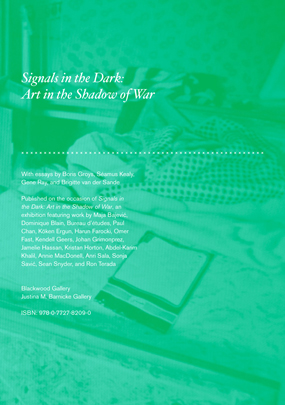
Produced in conjunction with the 2008 exhibition Signals in the Dark: Art in the Shadow of War
125 pages, softcover, partial colour, 15cm x 21cm
ISBN 978-0-7727-8209-0
$10.00

Signals in the Dark: Art in the Shadow of War, was published in conjunction with the 2008 inter-disciplinary project by the same title curated by Séamus Kealy at the Blackwood Gallery and the Justina M. Barnicke Gallery.This book explores contemporary art's relationship to war and its representations. The catalogue includes essays by Boris Groys, Gene Ray, Brigitte van der Sande, and Séamus Kealy.
Hundreds of the world’s regions today experience armed conflict. No single account, vision, or witness can glimpse the immensity of humanity’s unending self-destruction. More specifically, an exhibition project examining war and its representations—via contemporary art that confronts global war and its imaging and imagining—is little more than a whisper compared to the space a swollen, volatile international field of war occupies.
A new global Empire, Antonio Negri and Michael Hardt argue, has emerged as a “network power.” This new, imperial sovereignty includes “the dominant nation-states along with supranational institutions, major capitalist corporations and other powers” that must cooperate within their hierarchies. [1] From Empire emerges a constant state of war, the machine of war [2] functioning as a pure instrument of enforced rule. “Today’s imperial peace,” Hardt and Negri continue, “Pax Imperii, like that in the times of ancient Rome, is a false pretense of peace that really presides over the state of constant war.” [3]
It is argued that a tremendous portion of the machine of war is embedded in the simplest of transactions, interactions, policies, and socio-economic relationships—as well as in the language, behavior, learning, governance, and entertainment—that define (western) culture. This exhibition seeks out key symbioses of the machine of war as integrated within complexities of everyday western life. Considering these integrations, our complicity in global war seems indisputable; yet instead of embracing misanthropic resentment (as some of the exhibited artwork might), this project attempts to present an obverse of this complicity, imagining a surge of will unleashed through activation of what Negri and Hardt define as multitude. [4] United political mobilization—from various walks of life, like a universal, all-embracing Popular Front—is not only at its greatest potential, it might be starting to awaken to this potential.
This essay examines a few currents of global war alongside analyses of several artworks in the exhibition. Some art projects, punctuating and contradicting the exhibition’s focus, take audiences into a darker morass of war; some recount war’s absurdity, horror, and trauma; and some seemingly mock war and its representation. But all offer a lens on contexts of war, stirring up difficult subjects and imagery. Glances at over-reported (and greatly misrepresented) conflicts, such as the NATO invasion of Yugoslavia and the American/British coalition attack on Iraq, at times appear in this essay as points of departure for analyzing a universal campaign of global war. And instead of directly supporting research on war and its representations, several artworks in this project arise as models for imagining breakthroughs beyond the world of war as it is predominantly presented, particularly in its form of absolute war.”
–excerpted from “Maneuvering in the Shadows of War” by Séamus Kealy
1. Michael Hardt and Antonio Negri, Multitude, (New York: Penguin Press, 2004), xii.
2. The terms machine of war and war machine are used throughout this text, but have different meanings. The former term, my term, applies to the spell of conflicts(and their systems of representation and support) worldwide under a hierarchy of state and corporate control. The latter term is used dialectically as coined by Felix Guattari and Gilles Deleuze, and elaborated upon by Antonio Negri and Michael Hardt. Deleuze and Guattari draw a distinction between the war machine that they identify with nomadic culture and the military institutions traditionally identified with the state, essentially purporting that the war machine is exterior to the state apparatus.
3. Hardt and Negri, Multitude, xii.
4. Ibid.
Art at War p. 9
Boris Groys
History, Sublime, Terror: Notes on the Politics of Fear p. 23
Gene Ray
Maneuvering in the Shadows of Absolute War p. 49
Séamus Kealy
Brigitte van der Sande p. 97
Truth and Lies in War and Art
Exhibition Checklist p. 115
Film and Video Programme p. 116
Artist Biographies p. 117
Author Biographies p. 122
Acknowledgements p. 126
Maja Bajevic
Dominique Blain
Bureau d’etudes
Paul Chan
Köken Ergun
Harun Farocki
Omer Fast
Kendell Geers
Johan Grimonprez
Boris Groys
Jamelie Hassan
Kristan Horton
Séamus Kealy
Abdel-Karim Khalil
Annie MacDonell
Gene Ray
Anri Sala
Sonja Savic
Sean Snyder
Ron Terada
Brigitte van der Sande
To order any of our publications, please send an email including title(s), number of copies, and your mailing address to: michael.dirisio@utoronto.ca
A 20% discount is available to students and members of the Ontario Association of Art Galleries.